Looking to add some Korean flavor to your meals? Meet Korean cabbage, also known as napa cabbage. Napa cabbage is a staple in Korean cuisine, valued for its mild taste and crisp texture. It's often the star ingredient in kimchi, a fermented dish enjoyed as a side or condiment.
You'll find napa cabbage in countless other Korean vegetable dishes, like soups, stir-fries, and Korean street toast. This versatile vegetable can soak up flavors, making it perfect for various recipes, whether spicy, savory, or sweet.
If you've ever wondered why Korean meals have that delicious crunch? It's because of napa cabbage! It's easy to prepare and can be used fresh or fermented, giving you endless possibilities in the kitchen.
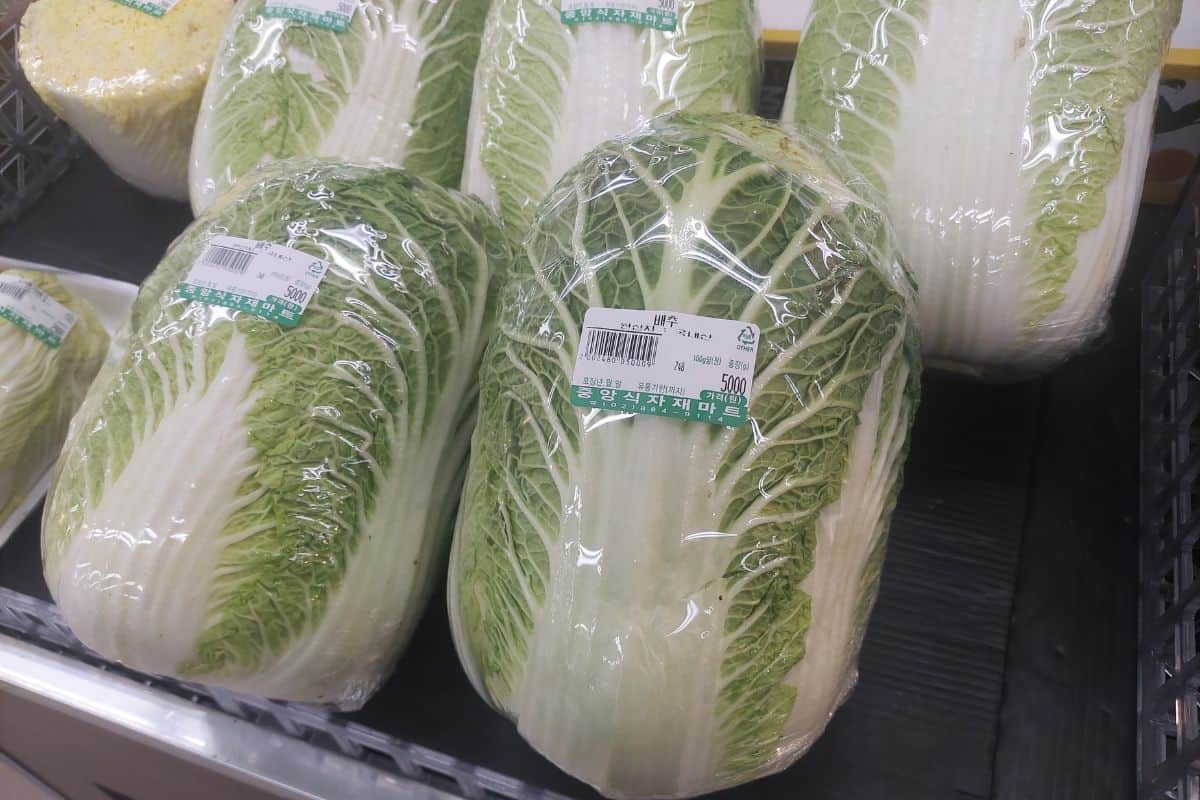
Jump to:
🥬 The Basics of Napa Cabbage
Characteristics of Napa Cabbage
Napa cabbage has an oblong shape and soft, crinkled leaves. These leaves are light green with thick white ribs and grow tightly packed together, making them quite heavy.
The cabbage can be quite large, often weighing several pounds. Its texture is tender, and when cooked, it has a mild, slightly sweet flavor. When raw, the leaves are crunchy and refreshing.
Farmers commonly grow napa cabbage in cool weather, as it thrives between 45°F and 75°F. This hardy plant can withstand light frost but doesn't do well in extreme heat.
Nutritional Profile
Napa cabbage is low in calories, making it a great addition to any diet. A single cup of raw cabbage contains around 9 calories. It’s also rich in vitamins C and K, boosting the immune system and helping in blood clotting.
This leafy vegetable is a good source of folate, which is essential for cell division and production. Additionally, it contains small amounts of calcium and potassium, which contribute to bone health and heart function.
Napa cabbage is high in fiber, aiding digestion and promoting a healthy gut. It contains antioxidants like beta-carotene and other beneficial plant compounds that can help reduce inflammation and support overall health.
Varieties of Napa Cabbage
There are several varieties of napa cabbage, each with unique characteristics. The most common type is the traditional green napa cabbage, often used in kimchi and stir-fries.
Another variety is the 'Heart of Gold,' known for its striking yellow interior and tender leaves. There is also a purple napa cabbage, which has a slightly sweeter taste and vibrant color, making it a popular choice for salads.
In some regions, you can find a mini napa cabbage, which is smaller and perfect for individual servings or small dishes. Each variety brings its own flavor and texture to the table, allowing for diverse culinary uses.
No matter which variety you choose, napa cabbage is a versatile and nutritious addition to many dishes.
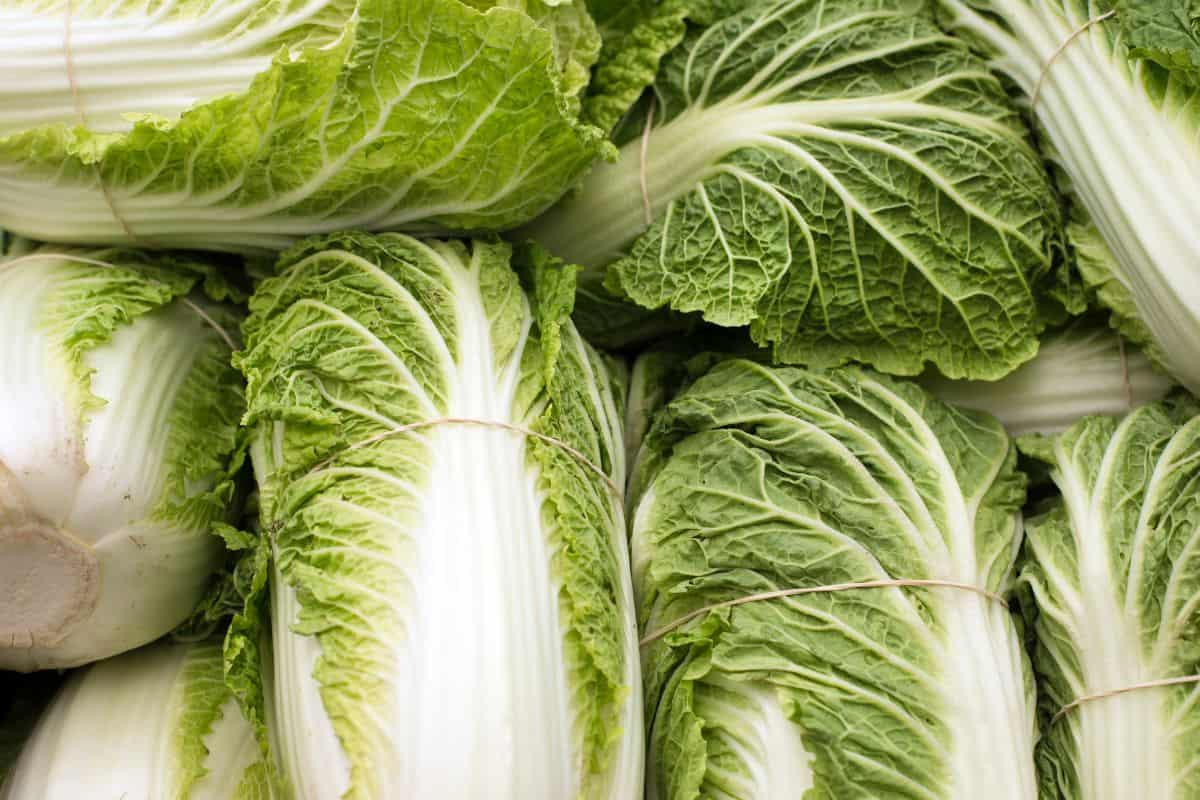
👨🍳 Culinary Uses
Traditional Korean Dishes
Napa cabbage is the key ingredient in many traditional Korean dishes. The most famous is kimchi, a fermented dish made with napa cabbage, Korean chili flakes, garlic, and ginger. Kimchi is served as a staple side dish in almost every Korean meal.
In soups, napa cabbage is often used to add texture and flavor. It can be found in dishes like baechu guk (napa cabbage soup) and kimchi jjigae (kimchi stew). These soups provide a warming comfort, especially during cold seasons.
Napa cabbage is also enjoyed in stir-fries, such as dakgalbi, where it is stir-fried with marinated chicken and vegetables. Its crunchy texture and mild flavor make it perfect for absorbing the rich flavors of Korean marinades and sauces.
Incorporation in Modern Cuisine
Modern chefs have incorporated napa cabbage into various dishes that blend traditional and contemporary flavors. One popular example is using napa cabbage in salads. It adds a crunchy texture and is often paired with sesame dressing or other Asian-inspired dressings for a fresh, light meal.
Another modern use is in sandwiches. A great example is gilgeori toast, a Korean street food sandwich filled with napa cabbage, eggs, and sometimes ham or cheese. This provides a quick and nutritious meal option.
Napa cabbage is used in fusion cuisine in dishes like tacos and wraps. Chefs are creatively mixing Korean flavors with other culinary traditions, making napa cabbage a versatile ingredient that works in many cooking styles.
🥗 Kimchi: Korea's Signature Dish
The History and Significance of Kimchi
Kimchi, also known as baechu kimchi, has a rich history dating back to ancient Korea. It originated as a method to preserve vegetables during harsh winters. Over centuries, this preserved dish became more diverse, incorporating various vegetables and spices.
One of the key ingredients is gochugaru, a type of Korean chili flake that gives kimchi its distinctive red color and spicy kick. The process starts with salting the cabbage to draw out moisture, followed by seasoning it with garlic, ginger, and radish, among other things.
The dish is deeply embedded in Korean culture. Families gather for kimjang every fall, the traditional practice of making large quantities of kimchi to last through the winter. This event fosters community spirit and ensures a supply of nutritious, fermented food.
There are many types of kimchi, but pogi kimchi is particularly popular. This version involves wrapping the seasoned leaves around the cabbage core. homemade kimchi recipes add a personal touch to this iconic dish, reflecting regional and familial flavors.
The fermentation process is essential, transforming the seasoned cabbage into a tangy, umami-rich side dish that pairs well with almost every meal. The probiotics produced during fermentation also offer numerous health benefits.
🔪 Preparation Techniques
Brining Napa Cabbage
Brining napa cabbage is crucial for enhancing its flavor and texture. Begin by cutting the cabbage into quarters and removing the tough core. Sprinkle coarse sea salt between the leaves, making sure to cover each layer.
Place the salted cabbage in a large bowl and let it sit for a few hours. This process draws out moisture, making the cabbage pliable and ready for seasoning. After brining, rinse the cabbage thoroughly to remove excess salt.
Fermentation Tips
Fermentation transforms seasoned cabbage into kimchi. To create the seasoning paste, start by mixing ingredients like Korean chili flakes, garlic, ginger, and sugar. You can also blend onion into the paste for an even mix.
Once the cabbage is seasoned, pack it tightly into a jar or container, eliminating air pockets. Leave some space at the top for the gases produced during fermentation.
Keep the container at room temperature for a few days before moving it to the refrigerator. This slows down fermentation but deepens the flavors over time.
Creating Vegan Kimchi Variants
Creating vegan kimchi involves simple adjustments to the traditional recipe. Typically, fish sauce or shrimp paste is used, but these can be replaced with alternatives like soy sauce, or miso paste for a vegan version.
Ensure all other ingredients, such as garlic, ginger, and Korean chili flakes, are vegan-friendly. Follow the same brining and fermentation techniques as with traditional kimchi. This way, you maintain the spicy, tangy profile without animal products.
Vegan kimchi still offers the savory and complex flavors that make kimchi a beloved dish.
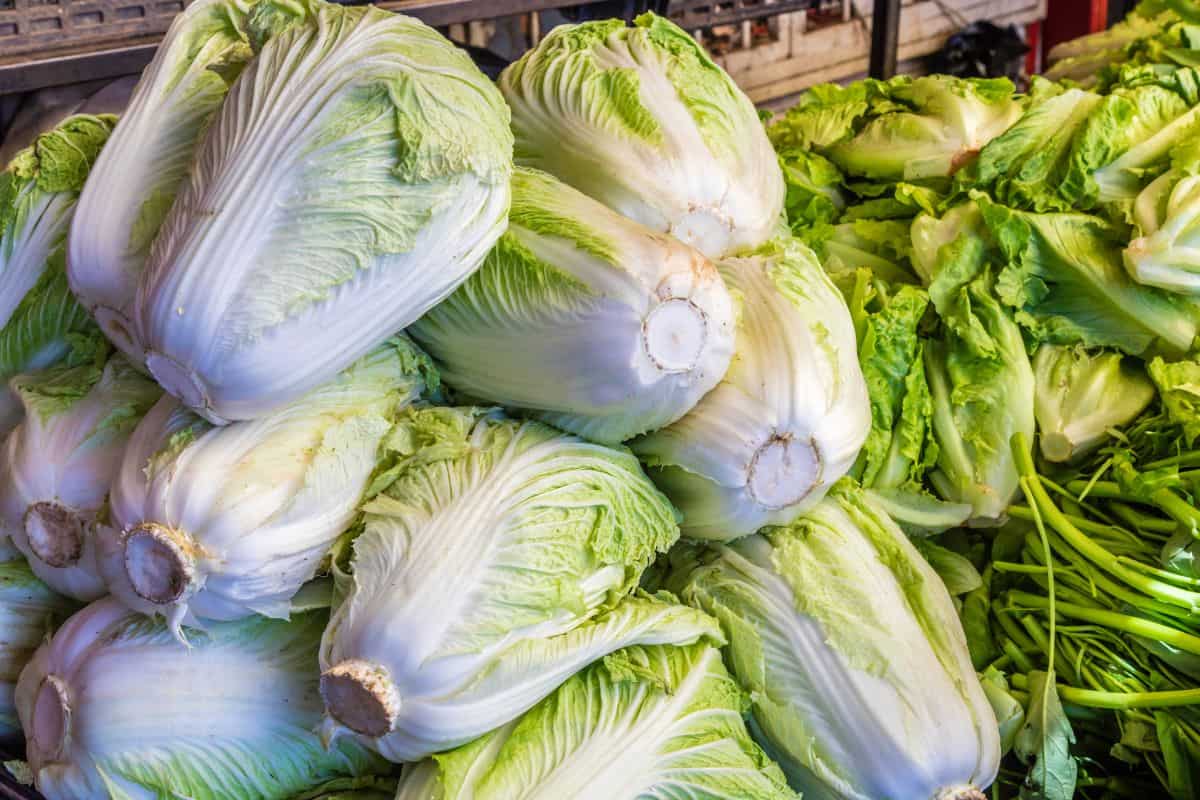
🧂 Ingredients and Seasonings
Essential Ingredients for Kimchi
Napa Cabbage is the star ingredient in many kimchi recipes. This type of cabbage is often chosen for its crisp texture and ability to hold up well during fermentation.
Radish, often the Korean variety called “mu,” adds crunch and absorbs flavors well.
Scallions or Green Onions provide a mild onion flavor and a bit of color.
Garlic and Ginger, usually minced, give kimchi its signature pungency and warmth.
Salted Shrimp (Saeujeot) and Fish Sauce are commonly used for umami depth.
Here's a small table summarizing these ingredients:
| Ingredient | Purpose |
|---|---|
| Napa Cabbage | Main vegetable, texture |
| Radish | Crunch, flavor absorption |
| Scallions | Mild onion flavor, color |
| Garlic and Ginger | Pungency, warmth |
| Salted Shrimp | Umami flavor |
| Fish Sauce | Umami flavor |
Commonly Used Seasonings
Gochugaru (Korean chili powder) is crucial for the spicy kick and vibrant red color of kimchi. It's available in coarse and fine varieties.
Salt is essential for drawing out moisture from the cabbage and radish, aiding in fermentation.
Sugar or apple/pear juice is often added to balance the saltiness and enhance fermentation.
Soy Sauce and Gochujang (fermented chili paste) might be included for added depth and complexity.
Minced Garlic and Ginger continue to enhance the aromatic profile of the dish.
Finally, Red Bell Pepper can sometimes be used for additional sweetness and color, although it's not as common.
These seasonings are typically combined to create the paste that coats the vegetables, providing the signature taste and characteristics of kimchi.
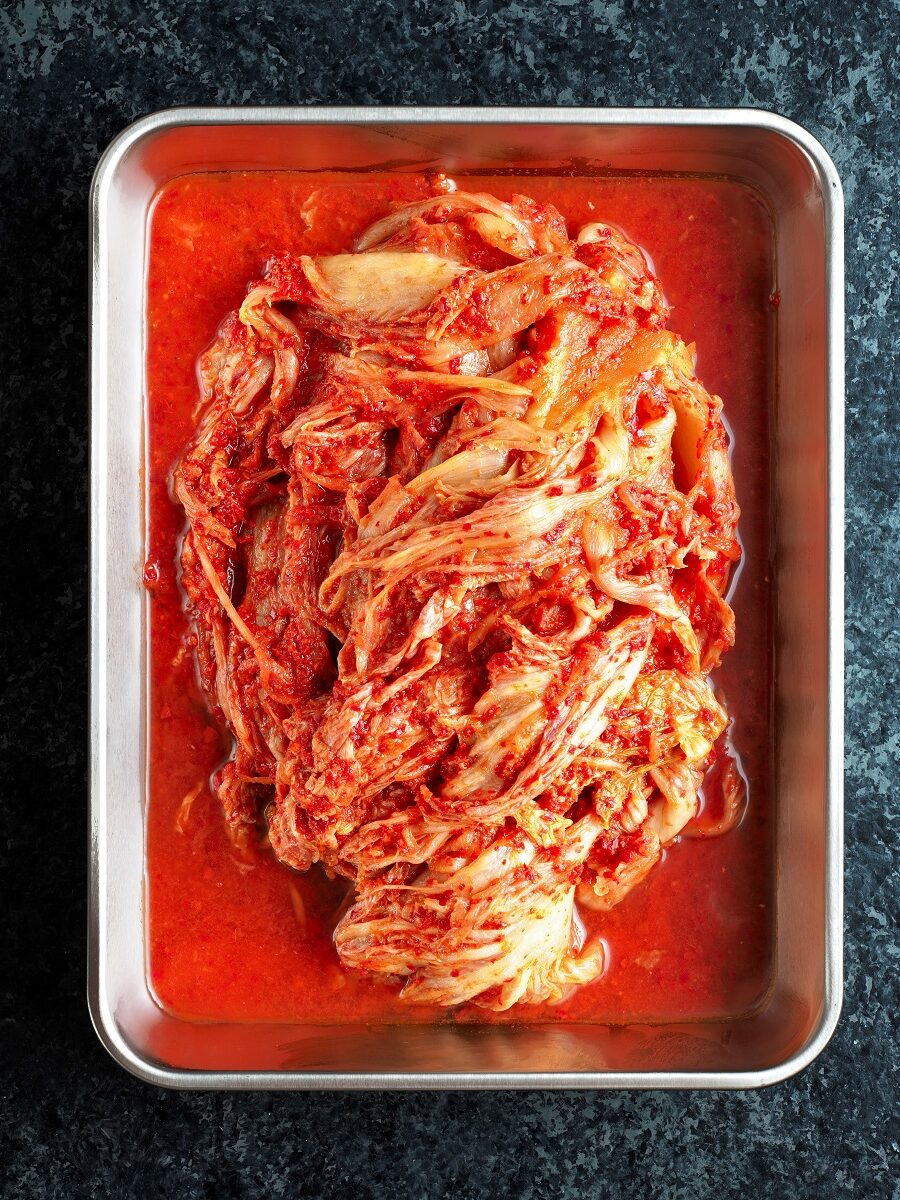
🥢 Storing and Serving Kimchi
Kimchi Storage Solutions
Kimchi needs to be stored correctly to preserve its taste and nutritional benefits. The best place to store kimchi is in the refrigerator. This slows down the fermentation process, keeping the kimchi from becoming too sour too quickly.
It's important to use an airtight container to prevent the kimchi from drying out and to keep odors from spreading in the fridge. Good options include traditional kimchi containers, which are often made of ceramic or glass. These containers are specifically designed to handle the fermentation process.
Stainless steel containers and BPA-free plastic containers are also suitable. Stainless steel is great because it's durable and does not absorb odors. BPA-free plastic containers are lightweight and easy to handle. Just make sure the container is airtight.
Serving Suggestions
Kimchi can be enjoyed in many ways, making it a versatile meal addition. It can be served as a side dish with almost any Korean meal. It's a classic pairing with rice and can add a tangy crunch to grilled meats.
Another popular way to use kimchi is in soups and stews. These dishes benefit from the rich flavors of the fermented cabbage. It can also be used as a topping for noodles or mixed into a stir-fry to give the dish an extra kick.
For a snack, try kimchi with some fresh vegetables or on top of a salad. Its unique taste and texture are both refreshing and satisfying.
👩⚕️ Health Benefits
Probiotics and Digestive Health
Napa cabbage is often used to make kimchi, a popular Korean dish. Kimchi is a probiotic food that contains healthy bacteria that benefit the gut.
These probiotics help maintain a healthy balance of microbes in your intestines, improving digestion and boosting the immune system. Eating napa cabbage in fermented forms, like kimchi, can reduce inflammation in the bowels and enhance nutrient absorption.
The healthy bacteria in kimchi also produce short-chain fatty acids, essential for your colon's health. Regular kimchi consumption may help prevent gastrointestinal disorders, making it a valuable addition to your diet.
Dietary and Nutritional Advantages
Napa cabbage is rich in vitamins and minerals. It contains high levels of vitamin K, vital for blood clotting and bone health. Napa cabbage also provides vitamin B9 (folate), which supports heart health by lowering homocysteine levels in the blood.
One cup of napa cabbage supplies a good amount of dietary fiber, contributing to better digestion and helping to maintain a healthy weight. Additionally, it offers copper, enhancing brain function. This makes napa cabbage a low-calorie vegetable that is nutrient-dense and beneficial for various bodily functions.
Adding napa cabbage to your meals can help improve your nutrient intake and support overall health. Whether eaten raw or cooked, it can be a versatile and delicious part of your diet.
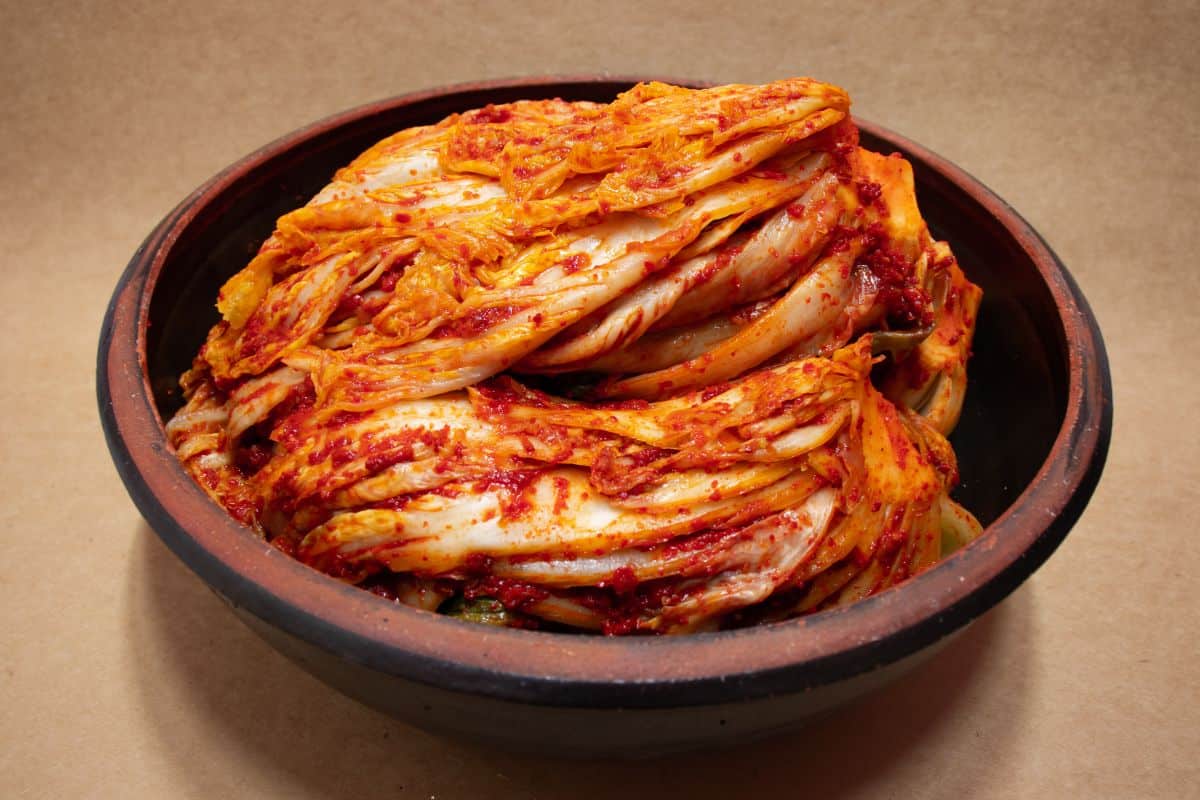
👘 Cultural Significance
Kimchi in Korean Tradition
Kimchi, a staple in Korean cuisine, is made primarily from napa cabbage. This fermented dish comes in many varieties, but the most common is baechu kimchi. Another popular type is kkakdugi, which uses radish instead of cabbage.
Every fall, families partake in kimjang, the communal practice of making large quantities of kimchi for the winter. This tradition maintains community bonds and ensures every household has enough kimchi for the colder months. Historically, kimjang was a way to preserve vegetables and embrace seasonal abundance.
Modern Korean cooking continues to draw inspiration from these traditions. Various kimchi recipes can be found that incorporate ingredients like Korean pear, which adds a subtle sweetness. This tradition is not just about food but also about community, culture, and heritage.
Global Influence of Korean Cuisine
Napa cabbage and its association with kimchi have spread far beyond Korea. Korean cuisine has grown in popularity globally, with kimchi leading the charge. Restaurants worldwide are incorporating kimchi into their menus, honoring both traditional methods and introducing new twists.
Kimchi is celebrated for its health benefits, and its distinct tangy flavor has made it a favorite among food enthusiasts. Chefs are inspired by the versatility of kimchi, using it in fusion cuisine—from kimchi tacos to kimchi burgers—introducing new audiences to its complexity.
Culinary shows and food bloggers often highlight Korean kimchi recipes, further broadening its reach. Napa cabbage's role in these recipes is crucial, showcasing how Korean cooking has inspired global culinary practices.
📝 Additional Tips and Tricks
Selecting the Best Napa Cabbage
To select the best napa cabbage, look for ones that are heavy for their size and have bright, crisp leaves. A good cabbage should not have any blemishes or brown spots.
Shop for fresh cabbage in late fall when it's in season and likely to be the freshest.
Avoid any cabbage that feels light, as it may be old or lack moisture. Storing the cabbage in a plastic bag in the fridge will help keep it fresher longer, preventing it from losing its crunch and flavor.
Making Kimchi at Home
Making kimchi at home can be labor-intensive but rewarding. To ensure the best flavor, start with fresh napa cabbage, fresh ginger, and yellow onion.
Cut the cabbage into quarters, salt it, and let it sit for a few hours to draw out excess water. This will help the cabbage absorb the marinade better.
Create the kimchi paste using ingredients like garlic, ginger, and fish sauce. Massage the paste thoroughly into each cabbage leaf for even flavoring.
Pack the cabbage tightly into a container and let it ferment at room temperature for a few days before transferring it to the fridge. The longer it ferments, the tangier it will taste.
Frequently Asked Questions
Napa cabbage is used in many East Asian dishes. In Korean cuisine, it’s often used to make baechu jeon, a savory pancake, and bossam, a dish with steamed pork. It’s also great for stir-fries and soups.
Napa cabbage has a mild, slightly sweet flavor. It's more tender than traditional green cabbage, making it a preferred choice for many recipes. Its light taste allows it to pair well with a variety of ingredients and seasonings.
Another name for Korean cabbage is baechu. This term is commonly used in Korea and often refers to napa cabbage in recipes and dishes.
Napa cabbage is low in calories and rich in vitamins A and C, which are important for the immune system and skin health. It also contains a good amount of potassium, which supports heart health.
While you can substitute other cabbages for napa cabbage, the texture and flavor will differ. Traditional green cabbage is firmer and has a stronger taste, which might alter the dish slightly.
Napa cabbage’s texture is tender and crisp, while traditional green cabbage is firmer and crunchier. In terms of flavor, napa cabbage is milder and sweeter, whereas green cabbage has a more pronounced, slightly peppery taste.

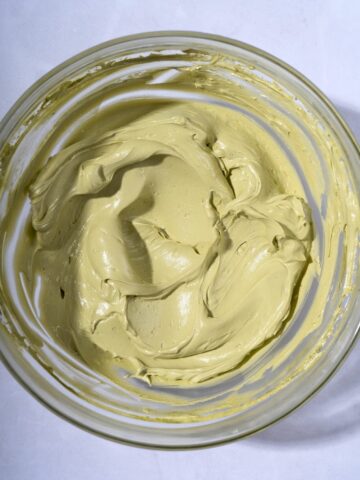


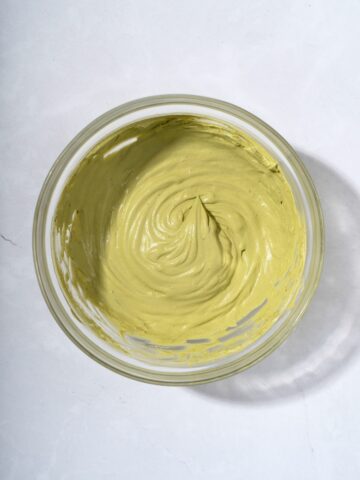
Comments
No Comments